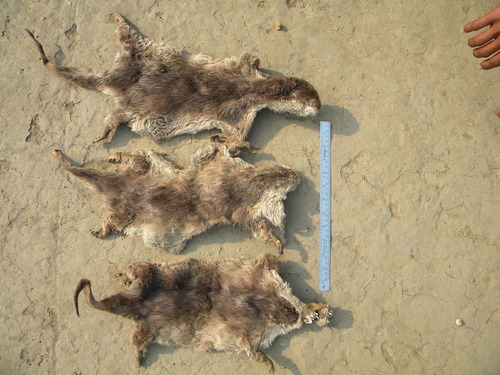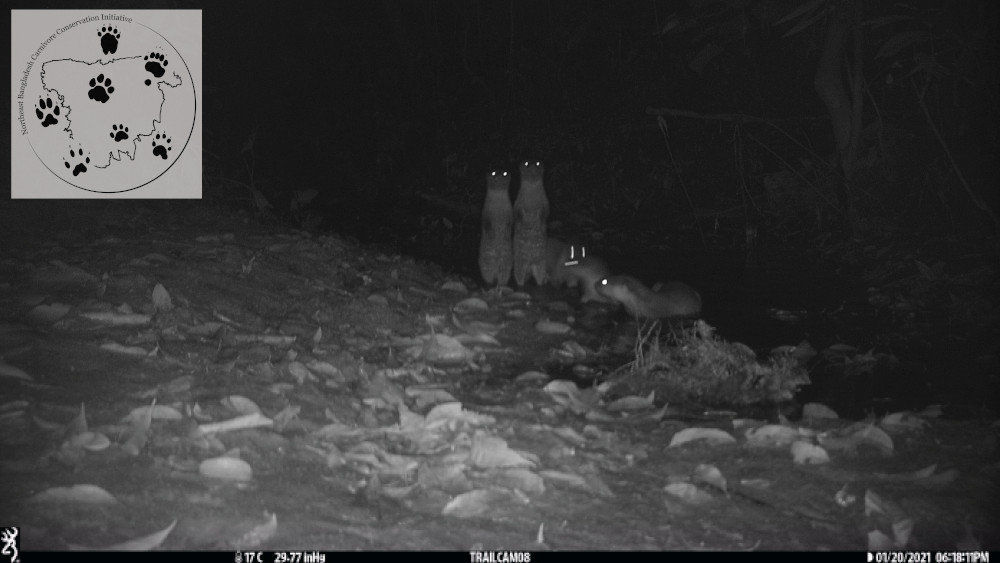The smallest of the planet’s 13 otter species finds its habitat shrinking every day. We know little about these mustelids — especially in Bangladesh, where I conduct my research — but they face a horde of threats.
 Species name and description:
Species name and description:
The Asian small-clawed otter (Aonyx cinereus) has a typical otter build with webbed digits, dark brown to blackish upper parts, and a pale vent. It can be distinguished from other otter species by its blunter muzzle, acutely arched back and a white neck devoid of any spots or streaks. Its claws are noticeably short and even often absent — a feature of its genus, Aonyx.
Where it’s found:
These otters live in the Himalayan foothills, Ganges Delta, Northeast India, Indochina, South China and Philippines, with isolated population in southern India. Their habitats range from forests and wetlands to coasts and mangroves. In Bangladesh they’re thought to be confined to the Sundarbans mangrove.

IUCN Red List status:
Vulnerable, with a globally decreasing population trend; endangered in Bangladesh
Major threats:
Poaching for fur and extraction to supply a recently spiked demand in pet trade is the number one threat to Asia’s most trafficked otter species. Habitat destruction, conflict with fishers, drying up streams, decreasing food supply and attacks by feral dogs are also affecting its already sharply plummeting population.

In Bangladesh there exists no study on the species outside the Sundarbans, its known habitat in the country. Even there, only a handful of research has been undertaken to date.
Notable conservation programs or legal protections:
In 2019 the species shifted to CITES Appendix I from Appendix II to plug the illegal trade and trafficking.
The IUCN Otter Specialist Group and International Otter Survival Fund are the strongest voices for the species. Although the animals are protected by law, there is no conservation scheme so far in Bangladesh.
My favorite experience:
Watching camera-trap footage of not one, not two, but multiple otter families is unforgettable. Hearing the cooing of otter pups on screen was heart-melting and one of those now-I-can-die-in-peace moments. And all these images were from a region that has long been deprioritized in conservation, without any prior systematic study.

However, the joy comes with a caveat. In all existing anecdotes, northeastern forests are described as the home of the larger Eurasian and smooth-coated otters. Otters showed up, true. But to my extreme surprise, it was a species that has always been attributed to the Sundarbans — a forest hundreds of miles away from the study site. Although finding the Asian small-clawed otter here has sparked hope for the region, the apparent absence of the other two expected species has left me with an uneasy feeling: Do the larger otters really roam these forests? Or is the Eurasian otter, the rarest of the three, to become the next extinct carnivore in Bangladesh?
What else do we need to understand or do to protect this species?
We need extensive studies on ecology and threats to the species in both known and newly discovered habitats in Bangladesh. Connecting otters with the exceptionally rich ichthyodiversity of riparian streams and mangrove creeks can strengthen conservation practices in the country.
Key research:
- Akash, M., Zakir, T. (2020) Appraising carnivore (Mammalia: Carnivora) studies in Bangladesh from 1971 to 2019 bibliographic retrieves: trends, biases, and opportunities,s15(12): 17105-17120
- Aziz, M.A. (2018) Notes on population status and feeding behaviour of Asian small-clawed Otter (Aonyx cinereus) in the Sundarbans Mangrove Forest of Bangladesh. IUCN Otter Specialist Group Bulletin 35(1): 3-10
- Duplaix, N., Savage, M. (2018) The global otter conservation strategy. IUCN/SSC Otter Specialist Group, Salem, Oregon, USA
![]()


